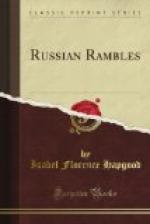The native cherries, small and sour, make excellent preserves, with a spicy flavor, which are much liked by Russians in their tea. The only objection to this use of them is that both tea and cherries are spoiled. Raspberries, plums, gooseberries, and currants were plentiful and cheap. A vegetable delicacy of high order, according to Katiusha, who introduced it to my notice, was a sort of radish with an extremely fine, hard grain, and biting qualities much developed, which attains enormous size, and is eaten in thin slices, salted and buttered. I presented the solitary specimen which I bought, a ninepin in proportions, to the grateful Katiusha. It was beyond my appreciation.
Pears do not thrive so far north, but in good years apples of fine sorts are raised, to a certain extent, in the vicinity of St. Petersburg. Really good specimens, however, come from Poland, the lower Volga, Little Russia, and other distant points, which renders them always rather dear. We saw few in our village that were worth buying, as the season was phenomenally cold, and a month or three weeks late, so that we got our strawberries in August, and our linden blossoms in September. Apples, plums, grapes, and honey are not eaten—in theory—until after they have been blessed at the feast of the Transfiguration, on August 18 (N. S.),—a very good scheme for giving them time to ripen fully for health. Before that day, however, hucksters bearing trays of honey on their heads are eagerly welcomed, and the peasant’s special dainty— fresh cucumbers thickly coated with honey—is indulged in unblessed. Honey is not so plentiful that one can afford to fling away a premature chance!
When the mushroom season came in, the market assumed an aspect of half-subdued brilliancy with the many sombre and high-colored varieties of that fungus. The poorer people indulge in numerous kinds which the rich do not eat, and they furnish precious sustenance during fasts, when so many viands are forbidden by the Russian Church and by poverty. One of the really odd sights, during the fast of Saints Peter and Paul (the first half of July), was that of people walking along the streets with bunches of pea-vines, from which they were plucking the peas, and eating them, pods and all, quite raw. It seemed a very summary and wasteful way of gathering them. This fashion of eating vegetables raw was imported, along with the liturgy, from the hot lands where the Eastern Church first flourished, and where raw food was suitable. These traditions, and probably also the economy of fuel, cause it to be still persisted in, in a climate to which it is wholly unsuited. Near Tzarskoe I found one variety of pea growing to the altitude of nearly seven feet, and producing pods seven inches long and three wide. The stalks of the double poppies in the same garden were six and seven feet high, and the flowers were the size of peonies, while the pods of the single poppies were nine inches in circumference.




